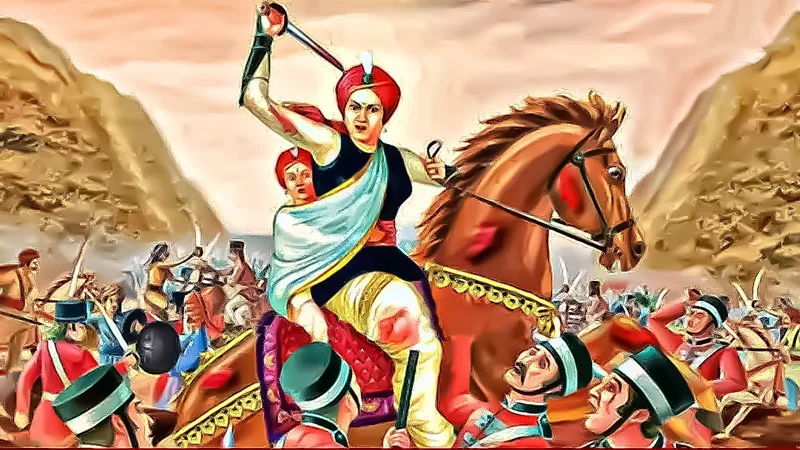The Brave Heart of Jhansi: Rani Lakshmi Bai
The Brave Heart of Jhansi: Rani Lakshmi Bai
Rani Lakshmi Bai, also known as the "Queen of Jhansi," is one of the most iconic figures in Indian history. A symbol of courage, resilience, and patriotism, she played a pivotal role in India's First War of Independence in 1857. Her name remains synonymous with valor, and her story continues to inspire millions of Indians, particularly women, who view her as a symbol of empowerment and resistance against British colonial rule.
Early Life and Marriage
Rani Lakshmi Bai was born on November 19, 1828, in Varanasi, India, as Manikarnika Tambe. She was nicknamed "Manu" by her family. Born into a Marathi Brahmin family, she was well-educated and skilled in horse riding, archery, and sword fighting—traits that would serve her well in the turbulent years ahead.
At the age of 14, she married the Maharaja of Jhansi, Raja Gangadhar Rao, and became the queen consort of the princely state of Jhansi. She was given the name Lakshmi Bai after her marriage. Despite being a queen, she did not live a life of luxury. She became deeply involved in the affairs of the kingdom, learning governance, and managing the state’s administration. She became beloved by the people of Jhansi due to her fair and just rule.
The British Annexation of Jhansi
The peaceful life of Rani Lakshmi Bai was disturbed in 1853 when her husband, Raja Gangadhar Rao, passed away. The British East India Company, which was expanding its control over India, sought to annex Jhansi under the Doctrine of Lapse, a policy introduced by Lord Dalhousie. This policy stated that if a ruler died without a natural heir, the state would be annexed by the British.
Rani Lakshmi Bai had given birth to a son, but the child soon died, and with no male heir, the British attempted to seize control of Jhansi. Lakshmi Bai, however, was determined not to let this happen. She appealed to the British for the rights of her adopted son, Damodar Rao, whom she had adopted as her heir. The British, under the leadership of Sir Hugh Rose, rejected her request and annexed Jhansi in 1854. This marked the beginning of her rebellion against the British.
The Revolt of 1857 and the Battle of Jhansi
The British annexation of Jhansi and the injustice faced by Rani Lakshmi Bai sparked a fire of resistance. The revolt of 1857, often referred to as India’s First War of Independence, was gaining momentum across the country. Rani Lakshmi Bai joined the uprising, and her kingdom of Jhansi became a central point of resistance. She led her army with remarkable courage and military skill.
In 1857, the British, aiming to suppress the revolt, laid siege to the fortified city of Jhansi. Rani Lakshmi Bai, despite being heavily outnumbered and facing overwhelming odds, fought back fiercely. She is said to have ridden into battle on horseback, wielding a sword, and leading her troops with exceptional bravery. Her leadership and her refusal to surrender made her a formidable figure in the revolt.
The Battle of Jhansi (March 1858) was one of the most famous confrontations of the First War of Independence. Despite her valiant efforts, Jhansi ultimately fell to the British forces. However, the Queen's heroic defense of the city became a symbol of resistance against British colonialism. After the fall of Jhansi, Rani Lakshmi Bai fled to Gwalior with her army to continue the fight for India's freedom.
The Final Stand and Martyrdom
Rani Lakshmi Bai's bravery was most evident in the Battle of Gwalior in June 1858. The British army, led by General Hugh Rose, pursued her to the fortress of Gwalior. Despite being surrounded and facing defeat, Lakshmi Bai continued to lead her forces with determination. In the heat of battle, she is said to have ridden her horse, carrying her adopted son, and fighting bravely until the end.
On June 18, 1858, during the Battle of Gwalior, Rani Lakshmi Bai was severely injured and died in combat. Her martyrdom was a tragic moment for India, but her legacy lived on. The British, recognizing her bravery, referred to her as a warrior queen, and her name became synonymous with the struggle for India’s independence.
Legacy and Impact
Rani Lakshmi Bai's legacy as a freedom fighter has been celebrated in Indian culture, literature, and history. Her courage in the face of colonial oppression, her refusal to accept the fate imposed upon her by the British, and her leadership during the revolt of 1857 have inspired generations of Indians.
She has been immortalized in numerous books, films, and songs, where she is depicted as a symbol of courage and resistance. Her life continues to be a source of inspiration for those who fight against injustice and oppression.
The Indian government later commemorated her memory by issuing a stamp in her honor, and many places in India, including the Lakshmi Bai National Institute of Physical Education, bear her name.
Rani Lakshmi Bai, the Queen of Jhansi, remains one of the most celebrated figures in India’s struggle for independence. A fierce warrior, a loving mother, and a determined leader, she fought for her kingdom, her people, and her nation. Her legacy continues to live on in the hearts of millions, as her story of courage, sacrifice, and patriotism endures through time. She is, without a doubt, a shining example of how one individual can inspire a movement and change the course of history.
Share With Friends And Always Check For New Blog And History Post


